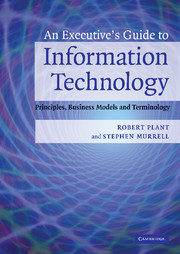Book contents
- Frontmatter
- Contents
- Introduction
- A ACM (Association for Computing Machinery) to Audio
- B Backup to Business process re-engineering
- C C, C++, C# to Cracking
- D Database to Dynamic web pages
- E e-Commerce/e-business to European Union Directive on Privacy and Electronic Commerce 2002
- F Fiber optics to Fuzzy logic
- G to H Global positioning system to Hypertext, HTML
- I ICANN (Internet Corporation for Assigned Names and Numbers) to ISP (Internet service provider)
- J to L Java to Logic programming
- M Machine learning to Multicast
- N Natural language processing (NLP) to Normalization
- O Object-oriented to Outsourcing
- P Packet switching and circuit switching to Public key-private key
- Q to R Quantum computing to RSS (Really simple syndication)
- S Sarbanes-Oxley Act of 2002 (SOX) to Structured design methodologies
- T to U T-Carrier to URL (Uniform resource locator)
- V Value added network (VAN) to Voice over IP (VoIP)
- W W3C (the World Wide Web Consortium) to WYSIWYG
- X to Z X.12 to Zip
- Index
- References
P - Packet switching and circuit switching to Public key-private key
Published online by Cambridge University Press: 17 May 2010
- Frontmatter
- Contents
- Introduction
- A ACM (Association for Computing Machinery) to Audio
- B Backup to Business process re-engineering
- C C, C++, C# to Cracking
- D Database to Dynamic web pages
- E e-Commerce/e-business to European Union Directive on Privacy and Electronic Commerce 2002
- F Fiber optics to Fuzzy logic
- G to H Global positioning system to Hypertext, HTML
- I ICANN (Internet Corporation for Assigned Names and Numbers) to ISP (Internet service provider)
- J to L Java to Logic programming
- M Machine learning to Multicast
- N Natural language processing (NLP) to Normalization
- O Object-oriented to Outsourcing
- P Packet switching and circuit switching to Public key-private key
- Q to R Quantum computing to RSS (Really simple syndication)
- S Sarbanes-Oxley Act of 2002 (SOX) to Structured design methodologies
- T to U T-Carrier to URL (Uniform resource locator)
- V Value added network (VAN) to Voice over IP (VoIP)
- W W3C (the World Wide Web Consortium) to WYSIWYG
- X to Z X.12 to Zip
- Index
- References
Summary
Foundation concept: Networks.
Overview
The standard model for a voice telephone system is a circuit switching network. When two users or end-stations wish to communicate, a direct connection must be made between them, and dedicated to that call for its duration. The connection may be through copper wires, fiber-optic cables, or even radio or microwave transmissions. It may pass though any number of switching stations, staffed by human operators with plug-boards, or electronically operated. It is even possible, using frequency shifting, for many conversations to be carried by the same wire at the same time. The key concept is that a complete connection must be made, then the conversation can happen, and then the connection may be dismantled.
Circuit switching allows very simple telephony equipment built on nineteenth-century technology to operate effectively (the first telephone exchange was working in 1877), but it does not allow very efficient use of the high-cost infrastructure (long-distance cables and transmitters).
The alternative is a Packet-switching network, and requires that all communications are in digital form. In a packetswitched network, every end-station has a permanent connection to at least one switching station; each switching station has a number of permanent connections to other switching stations. The connectivity does not change during use: connections are not made before data is transmitted or broken thereafter; there is a path (perhaps a very long path, through dozens of switching stations) from any end-station to any other.
- Type
- Chapter
- Information
- An Executive's Guide to Information TechnologyPrinciples, Business Models, and Terminology, pp. 250 - 276Publisher: Cambridge University PressPrint publication year: 2007

